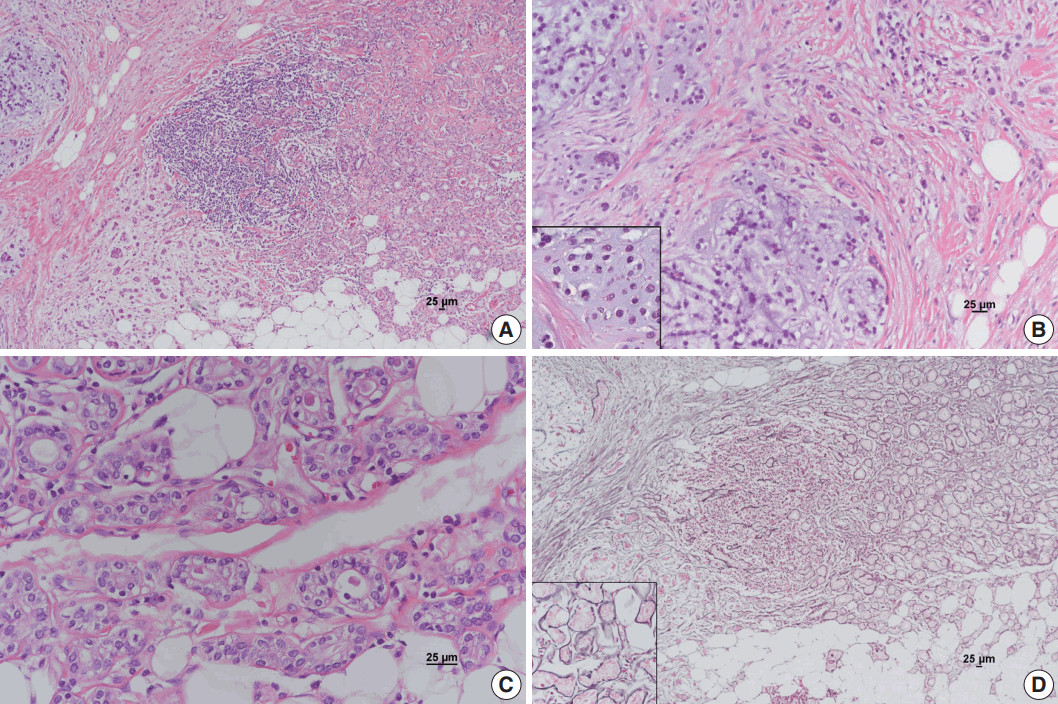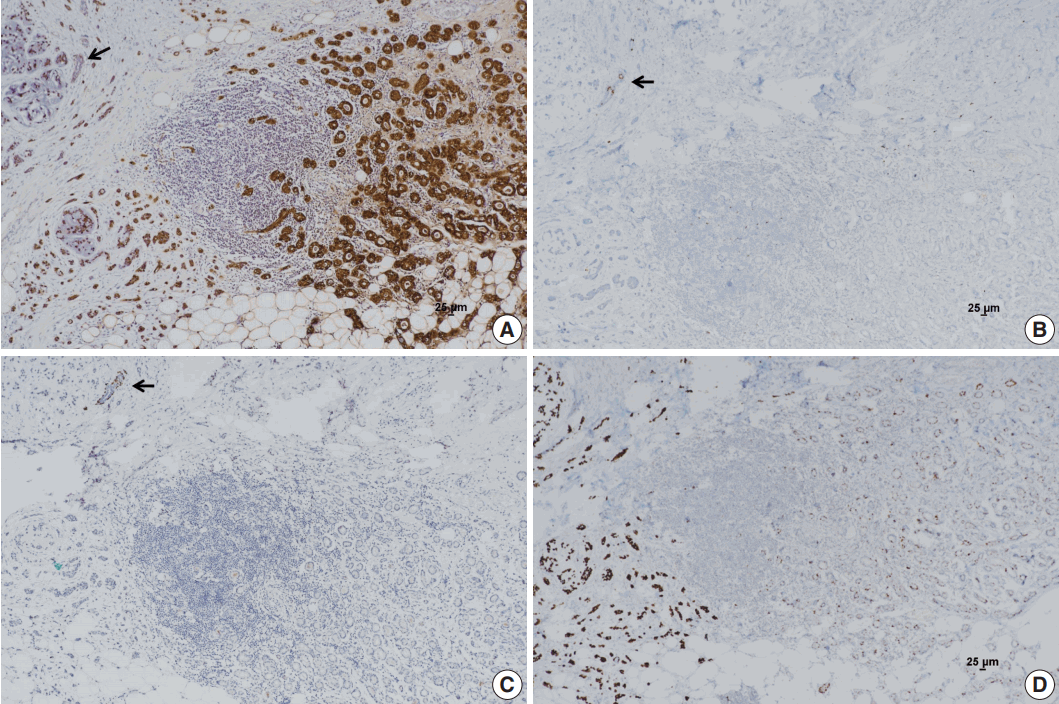This article has been
cited by other articles in ScienceCentral.
Abstract
Microglandular adenosis (MGA) of the breast is a rare, benign proliferative lesion but with a significant rate of associated carcinoma. Herein, we report an unusual case of metaplastic carcinoma with chondroid differentiation associated with typical MGA. Histologically, MGA showed a direct transition to metaplastic carcinoma without an intervening atypical MGA or ductal carcinoma in situ component. The immunohistochemical profile of the metaplastic carcinoma was mostly similar to that of MGA. In both areas, all the epithelial cells were positive for S-100 protein, but negative for estrogen receptor, progesterone receptor, HER2/neu, and epidermal growth factor receptor. An increase in the Ki-67 and p53 labelling index was observed from MGA to invasive carcinoma. To the best of our knowledge, this is the first case of metaplastic carcinoma with chondroid differentiation arising in MGA in Korea. This case supports the hypothesis that a subset of MGA may be a non-obligate morphologic precursor of breast carcinoma, especially the triple-negative subtype.
Go to :

Keywords: Breast, Metaplastic carcinoma, Fibrocystic breast disease
Microglandular adenosis (MGA) of the breast is a rare benign proliferative lesion that is often difficult to differentiate clinicopathologically from invasive carcinoma [
1,
2]. Breast carcinomas arising in MGA have occasionally been reported and metaplastic carcinoma is an extremely rare subtype of breast carcinoma–associated MGA [
3-
9]. In Korea, Choi and Bae [
9] previously reported the first two cases of invasive carcinoma arising in MGA. Invasive carcinomas arising in MGA usually show a transition from typical MGA through atypical MGA to carcinoma. Herein, we report an unusual case of metaplastic carcinoma with chondroid differentiation associated with typical MGA. To the best of our knowledge, this is the first case of metaplastic carcinoma arising in MGA reported in Korea.
CASE REPORT
A 60-year-old female presented with a palpable breast mass in the left breast. Ultrasound-guided core needle biopsy revealed invasive carcinoma. Preoperative breast magnetic resonance imaging showed an irregular solid mass approximately 1.5 cm in size in the upper outer quadrant of the left breast, which showed good contrast enhancement. A conserving operation was performed. Grossly, a grey to white colored, hard mass with ill-defined borders measuring 1.5 cm×1.2 cm×1 cm was observed. Microscopically, the tumor was composed of an invasive carcinoma area and MGA area (
Fig. 1A). Invasive carcinoma of no special type, grade 2 with an abrupt transition to chondroid matrix without an intervening spindle cell sarcomatoid component was observed (
Fig. 1B). The chondroid matrix comprised 70% of the invasive area. Focal chondroid differentiation in the chondroid matrix area was found, thus the patient was diagnosed with metaplastic carcinoma with chondroid differentiation. In the MGA area, small round glands lined by a single layer of cuboidal epithelial cells were diffused throughout the fibrous or adipose breast tissues (
Fig. 1C). Some of the glands were filled with a colloid-like secretion. No obvious architectural complexity or cytological atypia was present. MGA showed direct transition to metaplastic carcinoma without an intervening atypical MGA or ductal carcinoma
in situ area. The glands in MGA were surrounded by a basement membrane, which was clearly demonstrated by reticulin staining. However, the basement membrane was disrupted around the invasive nests of the metaplastic carcinoma (
Fig. 1D). The immunohistochemical profile of metaplastic carcinoma was nearly identical to that of MGA. In both instances, the epithelial cells were positive for cytokeratin (CK) 7 and S-100 protein, but negative for estrogen receptor (ER), progesterone receptor (PR), HER2/neu, and epidermal growth factor receptor (EGFR) (
Fig. 2A,
B). Other basal-like markers such as CK 5/6 and nestin were negative. No myoepithelial cells were demonstrated on immunohistochemical stainings for both smooth muscle myosin heavy chain and p63 (
Fig. 2C). Ki-67 and p53 were positive in MGA and metaplastic carcinoma but tended to show a more intense staining in metaplastic carcinoma (
Fig. 2D). The percentage of p53 and Ki-67 positive cells was 5% and 3% in MGA and 90% and 45% in metaplastic carcinoma, respectively. This case was finally diagnosed as metaplastic carcinoma with chondroid differentiation arising in MGA.
 | Fig. 1.Metaplastic carcinoma with mesenchymal differentiation arising in microglandular adenosis (MGA). (A) MGA on the right shows direct transition to invasive carcinoma on the left. (B) Invasive carcinoma primarily composed of cord-like cells scattered in the chondromyxoid matrix with focal chondroid differentiation (inset). (C) Typical glands in MGA are lined by uniform cuboidal cells regularly spaced around a lumen containing a colloid-like secretion. (D) Basement membranes highlighted by the reticulin stain are preserved in the MGA area (inset) but disrupted in the invasive carcinoma area. 
|
 | Fig. 2.Immunohistochemical stains. (A) S-100 protein is strongly positive in microglandular adenosis (MGA) and invasive carcinoma. Entrapped normal mammary gland is negative for S-100 protein (arrow). (B) Estrogen receptor (ER) is positive in entrapped normal mammary glands (arrow); however, MGA and invasive carcinoma are negative for ER. (C) No immunoreactivity for p63 is observed in the MGA area or invasive carcinoma area. Normal mammary glands are stained positively in myoepithelial cells (arrow). (D) An increase in p53 labelling index is observed from MGA to invasive carcinoma. 
|
No metastasis was found in the sentinel lymph nodes. After surgery, the patient received adjuvant chemoradiotherapy. After 14 months of follow-up, no evidence of recurrence was observed.
Go to :

DISCUSSION
MGA of the breast is a rare, benign glandular proliferative lesion that mimics invasive carcinoma clinicopathologically [
1,
2]. Carcinoma arising in MGA has previously been reported [
3-
8]. The incidence of invasive carcinoma ranges from 23%–64% in patients with MGA [
3,
8]; the high upper limit may be due to referral bias at institutions [
5].
Invasive breast carcinomas arising in MGA have various histological features [
1]. Invasive carcinoma of no special type is the most common type of carcinoma arising in MGA. Specialized variants of carcinoma, including carcinoma with secretory differentiation, carcinoma with squamous differentiation, acinic cell carcinoma, and adenoid cystic carcinoma, have also been reported [
3-
8]. Metaplastic carcinoma of the breast represents 0.2%–5% of all invasive carcinomas [
6]. Metaplastic carcinoma with mesenchymal differentiation is an extremely rare subtype of breast carcinoma arising in MGA [
8]. Structural transitions from MGA to atypical MGA and intraductal carcinoma and to invasive carcinoma are usually observed in invasive carcinomas arising in MGA [
3-
8].
In the present case, invasive carcinoma showed abrupt transition to chondroid matrix without an intervening spindle cell component. An intervening atypical MGA or ductal carcinoma in situ component between MGA and invasive carcinoma was not observed. Histologically, this case was consistent with metaplastic carcinoma with chondroid differentiation associated with typical MGA.
The main histological difference between MGA and MGA-associated invasive carcinoma is the presence of a basement membrane. The glands in MGA are surrounded by a basement membrane that can be highlighted using reticulin staining, periodic acid-Schiff staining, and immunohistochemical stains for type IV collagen and laminin. However, the basement membrane in MGA-associated carcinoma is disrupted around invasive nests.
The immunohistochemical profile of invasive carcinoma arising in MGA is similar to that of MGA [
3-
6,
8]. No myoepithelial cells are found in MGA and related lesions. The epithelial cells are usually positive for CK 7 and S-100 protein, but negative for ER, PR, and HER2/neu. In the present case, all the epithelial cells in MGA and invasive carcinoma were strongly immunoreactive for S-100 protein and negative for ER, PR, and HER2/neu, which was consistent with a triple-negative immunoprofile. Although the positivity for basal-like markers such as EGFR, CK 5/6, and nestin has been described in MGA and associated lesions [
8], epithelial cells in the present case lacked these markers. Several studies have reported a trend toward increased positivity for the p53 and proliferation marker Ki-67 together with increased severity of the lesions [
4,
5]. In the present case, metaplastic carcinoma showed a higher percentage of staining for p53 and Ki-67 than MGA. The identification of MGA and its direct transition to invasive lesions and the maintenance of the characteristic immunoprofile of MGA and invasive carcinoma associated with MGA in this study provided strong evidence suggesting that an MGA subset may constitute a non-obligate morphological precursor of invasive breast carcinoma, especially the triple-negative subtype.
Recent molecular genetic studies including massively parallel sequencing approaches provide further evidence to support the hypothesis that MGA is, at least in several cases, a neoplastic, clonal lesion and may be a non-obligate precursor for triple-negative or basal-like breast carcinomas [
10,
11].
The treatment of carcinomas arising in MGA follows the same general guidelines for breast carcinomas. The prognosis of invasive carcinoma arising in MGA varies in the literature. Some authors reported that patients with invasive carcinoma arising in MGA have a relatively favorable prognosis [
3,
7]. Another study, however, showed that the outcome for patients with invasive carcinoma arising in MGA ranged from favorable to unfavorable [
5]. In our patient, no axillary lymph node metastasis was found. Metaplastic carcinoma, the subtype of invasive carcinoma found in the present case, has lower response rates to conventional adjuvant chemotherapy and a worse clinical outcome than other forms of triple-negative breast cancers. Because metaplastic carcinoma arising in MGA is extremely rare, the prognosis of the lesion requires further characterization with more cases and longer follow-up.
Go to :







 PDF
PDF Citation
Citation Print
Print


 XML Download
XML Download